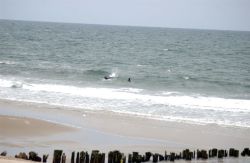Jamaica Bay and the Rockaways
Sandpiper Playground
This park honors the sandpipers that can be found at nearby Rockaway Beach. These small birds make their way though this area during a long winter migration from their arctic nesting sites.
The term “sandpiper” can be used to refer to a number of small shore birds in the scolopacidae family. All the birds in this family have the same general shape; they are usually the size of a sparrow or a thrush (about seven inches tall) and have relatively long, slender bills and legs, with narrow wings and short tails. Many sandpipers nest in arctic and sub-arctic regions, then migrate each winter in large leader-less flocks to the North Temperate Zone, passing through places like New York.
Sandpipers feed along beaches and mud flats. Running along the water’s edge and poking their bills into the sand, the avians “pipe” insects, crustaceans, and worms out of the moist soil as the waves rush on and off the beach. This may be the origin of their name, but there remains another equally plausible explanation. The name might otherwise come from the pipe-like noises often made as they move through the air and along the ground.
In their Arctic nesting grounds, the sandpipers usually lay four spotted eggs out in the open. After breeding in the spring, the spotted sandpiper (Actitis macularia), the most popular sandpiper in the United States, migrates as far south as Argentina during the winter. According to birdwatchers, one can identify a spotted sandpiper by their distinctive, teetering walk. Other types of these birds include the solitary sandpiper (Tringa solitaria); unique in that it does not lay eggs on the ground. Instead, it seeks out trees with abandoned nests made by other birds and seizes it for its own breeding purposes. The smaller sandpipers are usually part of the genus calidris. For example, one sandpiper in this genus (C. minutilla) is only 15 centimeters long and spends its winters along the coastlines between North Carolina and South America.
This long, narrow playground is located along the shores of Rockaway Beach on Shorefront Parkway between 106th and 107th street. Parks acquired Coney Island Beach in Brooklyn and South Beach in Staten Island from the City by charter in 1938. Commissioner Stern changed the name of this playground from Beach 106 Playground to Sandpiper Playground in January 2000. The playground along the waterfront is home to two sets of play equipment with safety surfacing and seal animal art.
In 1999, Mayor Giuliani and Borough President Claire Schulman funded a $137,808 renovation. In addition to the play equipment, there are tables nearby where beach-goers can enjoy a picnic, birdwatch, and admire the waterfront.
Check out your park's Vital Signs
Clean & Safe
Green & Resilient
Empowered & Engaged Users
Share your feedback or learn more about how this park is part of a
Vital Park System

Know Before You Go
Ecology Park is only open at certain times of year when Parks staff are present in order to protect this unique landscape. Want to visit? Check out our Stewardship Projects page for restoration, planting, and educational events.



